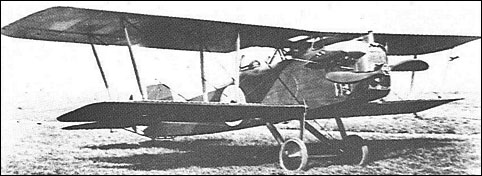|
| A two-seat fighter-reconnaissance aircraft, the F.B.24 was yet another Vickers aircraft originally designed for the ill-fated and Vickers-sponsored Hart radial engine. The prototype was completed in December 1916, but unavailability of the Hart engine resulted in its modification to accept the 150hp Hispano-Suiza water-cooled engine as the F.B.24A, and the second airframe, the F.B.24B, being similarly powered. An unequal-span two-bay biplane, the F.B.24 had an armament of one fixed synchronised Vickers gun and one Lewis on a Scarff ring mounting. Both F.B.24A and 24B were re-engined with the 200hp Hispano-Suiza with which they were redesignated as F.B.24Ds. Similar in general configuration was the F.B.24C, which was powered by a 275hp Lorraine-Dietrich 8Bd water-cooled eight-cylinder Vee-type engine and armed with two synchronised Vickers guns, provision being made for emergency dual control in the gunner's cockpit. The F.B.24C and D both possessed good performance, but the limited view offered from the pilot's cockpit was considered unacceptable. Consequently, the Vickers team revised the basic design by lowering the upper wing so that it was attached directly to the upper longerons, the front cockpit being situated between the wing spars. With this change, the aircraft was de
signated F.B.24E and power was provided by a 200hp Hispano-Suiza. This same configuration was adopted for yet a further version of the design, the F.B.24G, which was a larger aircraft than its predecessors, with two-bay wings of equal span and chord and a 375hp Lorraine-Dietrich 12-cylinder Vee-type engine. The F.B.24G was built in France by the Darracq concern, but it did not fly until 26 May 1919, and its performance and fate have gone unrecorded.
 | A three-view drawing (1278 x 858) |
| MODEL | F.B.24D |
| WEIGHTS |
| Take-off weight | 11.84 kg | 26 lb |
| Empty weight | 739 kg | 1629 lb |
| DIMENSIONS |
| Wingspan | 10.82 m | 36 ft 6 in |
| Length | 7.92 m | 26 ft 0 in |
| Wing area | 31.59 m2 | 340.03 sq ft |
| PERFORMANCE |
| Max. speed | 190 km/h | 118 mph |
|
Do you have any comments?
|
| 
COMPANY
PROFILE
All the World's Rotorcraft
|







